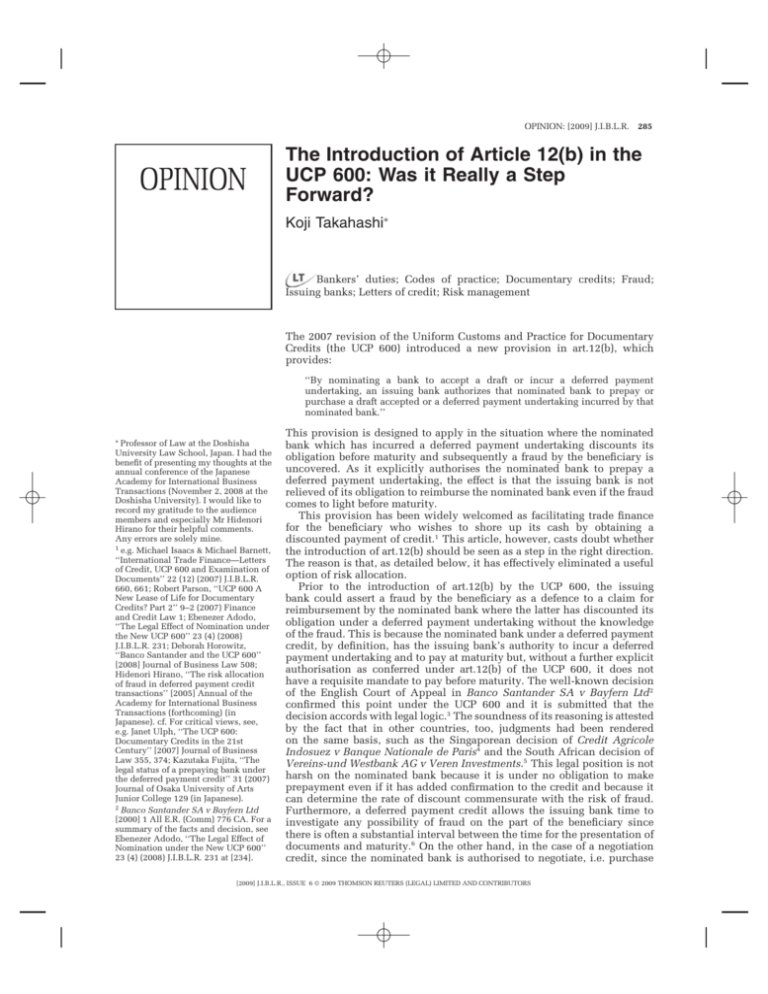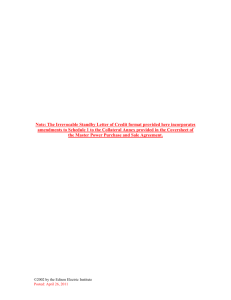UCP 600 Article 12(b): A Step Forward? - Legal Opinion
advertisement

OPINION: [2009] J.I.B.L.R. 285 OPINION The Introduction of Article 12(b) in the UCP 600: Was it Really a Step Forward? Koji Takahashi∗ Bankers’ duties; Codes of practice; Documentary credits; Fraud; Issuing banks; Letters of credit; Risk management The 2007 revision of the Uniform Customs and Practice for Documentary Credits (the UCP 600) introduced a new provision in art.12(b), which provides: ‘‘By nominating a bank to accept a draft or incur a deferred payment undertaking, an issuing bank authorizes that nominated bank to prepay or purchase a draft accepted or a deferred payment undertaking incurred by that nominated bank.’’ ∗ Professor of Law at the Doshisha University Law School, Japan. I had the benefit of presenting my thoughts at the annual conference of the Japanese Academy for International Business Transactions (November 2, 2008 at the Doshisha University). I would like to record my gratitude to the audience members and especially Mr Hidenori Hirano for their helpful comments. Any errors are solely mine. 1 e.g. Michael Isaacs & Michael Barnett, ‘‘International Trade Finance—Letters of Credit, UCP 600 and Examination of Documents’’ 22 (12) (2007) J.I.B.L.R. 660, 661; Robert Parson, ‘‘UCP 600 A New Lease of Life for Documentary Credits? Part 2’’ 9–2 (2007) Finance and Credit Law 1; Ebenezer Adodo, ‘‘The Legal Effect of Nomination under the New UCP 600’’ 23 (4) (2008) J.I.B.L.R. 231; Deborah Horowitz, ‘‘Banco Santander and the UCP 600’’ [2008] Journal of Business Law 508; Hidenori Hirano, ‘‘The risk allocation of fraud in deferred payment credit transactions’’ [2005] Annual of the Academy for International Business Transactions (forthcoming) (in Japanese). cf. For critical views, see, e.g. Janet Ulph, ‘‘The UCP 600: Documentary Credits in the 21st Century’’ [2007] Journal of Business Law 355, 374; Kazutaka Fujita, ‘‘The legal status of a prepaying bank under the deferred payment credit’’ 31 (2007) Journal of Osaka University of Arts Junior College 129 (in Japanese). 2 Banco Santander SA v Bayfern Ltd [2000] 1 All E.R. (Comm) 776 CA. For a summary of the facts and decision, see Ebenezer Adodo, ‘‘The Legal Effect of Nomination under the New UCP 600’’ 23 (4) (2008) J.I.B.L.R. 231 at [234]. This provision is designed to apply in the situation where the nominated bank which has incurred a deferred payment undertaking discounts its obligation before maturity and subsequently a fraud by the beneficiary is uncovered. As it explicitly authorises the nominated bank to prepay a deferred payment undertaking, the effect is that the issuing bank is not relieved of its obligation to reimburse the nominated bank even if the fraud comes to light before maturity. This provision has been widely welcomed as facilitating trade finance for the beneficiary who wishes to shore up its cash by obtaining a discounted payment of credit.1 This article, however, casts doubt whether the introduction of art.12(b) should be seen as a step in the right direction. The reason is that, as detailed below, it has effectively eliminated a useful option of risk allocation. Prior to the introduction of art.12(b) by the UCP 600, the issuing bank could assert a fraud by the beneficiary as a defence to a claim for reimbursement by the nominated bank where the latter has discounted its obligation under a deferred payment undertaking without the knowledge of the fraud. This is because the nominated bank under a deferred payment credit, by definition, has the issuing bank’s authority to incur a deferred payment undertaking and to pay at maturity but, without a further explicit authorisation as conferred under art.12(b) of the UCP 600, it does not have a requisite mandate to pay before maturity. The well-known decision of the English Court of Appeal in Banco Santander SA v Bayfern Ltd2 confirmed this point under the UCP 600 and it is submitted that the decision accords with legal logic.3 The soundness of its reasoning is attested by the fact that in other countries, too, judgments had been rendered on the same basis, such as the Singaporean decision of Credit Agricole Indosuez v Banque Nationale de Paris4 and the South African decision of Vereins-und Westbank AG v Veren Investments.5 This legal position is not harsh on the nominated bank because it is under no obligation to make prepayment even if it has added confirmation to the credit and because it can determine the rate of discount commensurate with the risk of fraud. Furthermore, a deferred payment credit allows the issuing bank time to investigate any possibility of fraud on the part of the beneficiary since there is often a substantial interval between the time for the presentation of documents and maturity.6 On the other hand, in the case of a negotiation credit, since the nominated bank is authorised to negotiate, i.e. purchase [2009] J.I.B.L.R., ISSUE 6 2009 THOMSON REUTERS (LEGAL) LIMITED AND CONTRIBUTORS 286 OPINION: [2009] J.I.B.L.R. 3 Commentaries making similarly positive appraisals include, e.g. Daniel Aharoni & Adam Johnson ‘‘Fraud and Discounted Deferred Payment Documentary Credits: The Banco Santander’’ 15 (2000) J.I.B.L.R. 22, 25; ‘‘Presenters Immune from the Fraud Rule in the Law of Letters of Credit’’[2002] Lloyd’s Maritime & Commercial Law Quarterly 10, 20; Eyal Berger, ‘‘Putting Florida Buyers on par with International Buyers: A Cost-Benefit Analysis of Revising Florida Statute’’ 675.109(1)(A)(4)’’ 16 (2004) Fla. J. Int’l L. 529. 4 Credit Agricole Indosuez v Banque Nationale de Paris [2001] 2 S.L.R. 1. 5 Vereins-und Westbank AG v Veren Investments 2000 (4) S.A. 238. Eyal Berger, ‘‘Putting Florida Buyers on par with International Buyers: A Cost-Benefit Analysis of Revising Florida Statute’’ 675.109(1)(A)(4)’’ 16 (2004) Fla. J. Int’l L. 529 at [535], says that the judgment to the same effect were rendered in France, Germany, Switzerland and Israel, though it relies on a somewhat dated material, A. Moher, ‘‘Discounting of Deferred Payment Credits—Comparative Aspects’’ 10 (1983) Banking & Fin. L. Rev. 379, 388. 6 As noted by Adodo Ebenezer Adodo, ‘‘The Legal Effect of Nomination under the New UCP 600’’ 23 (4) (2008) J.I.B.L.R. 231 at [232], 390 days from the date of bills of lading in Czarnikow-Rionda Sugar Trading Inc v Standard Bank London Ltd [1999] 1 All E.R. (Comm) 890, [1999] 2 Lloyd’s Rep. 187; 360 days in Vereins-und Westbank AG v Veren Investments 2000 (4) S.A. 238; 180 days from the date of presentation of the specified documents in Credit Agricole Indosuez v Banque Nationale de Paris [2001] 2 S.L.R. 1; 180 days from the date of bills of lading in Banco Santander SA v Bayfern Ltd [2000] 1 All E.R. (Comm) 776 CA. 7 See European Asian Bank AG v Punjab & Sind Bank (No.2) [1983] 1 W.L.R. 642 CA. 8 In Credit Agricole Indosuez v Banque Nationale de Paris [2001] 2 S.L.R. 1, the Singapore Court of Appeal considered whether the letter of credit at issue was a deferred payment credit or a negotiation credit on the assumption that the 2 types of credit differ in this respect. 9 Commentary on UCP 600 (ICC Publication No.680) p.54. 10 A credit must state whether it is available by sight payment, deferred payment, acceptance or negotiation: art.6(b) of the UCP 600. drafts and/or documents on or before reimbursement from the issuing bank is due, the issuing bank cannot assert a fraud by the beneficiary which has been revealed after the nominated bank purchased a complying presentation.7 It follows that prior to the introduction of art.12(b), the risk of fraud could be allocated between, on the one hand, the issuing bank or ultimately the applicant and, on the other, the nominated bank by choosing between the negotiation credit and the deferred payment credit.8 Thus, if an applicant has a good knowledge of its customer qua the beneficiary, it may not be reluctant to embrace the risk of fraud on the part of the latter. In such cases, a negotiation credit could be chosen. In other cases, the beneficiary which has a proven record of integrity with its banks may be confident that it could arrange for a discount of credit. In such cases, a deferred payment credit could be chosen. This distinction between the two types of credit has been removed by the introduction of art.12(b) by the UCP 600,9 with the result that the risk of fraud now lies with the issuing bank or ultimately the applicant, regardless of which basic type of credit is used, be it the sight payment credit, acceptance credit, negotiation credit or deferred payment credit.10 Consequently, if the issuing bank or the applicant is to avoid the risk of fraud, it would be necessary11 to insert in their letter of credit a clause excluding the application of art.12(b).12 It would be safe to say generally that as between a rule which makes a useful option readily available and a rule which has to be excluded in order to make room for a useful option, the former is superior for its better usability. In the present context, the exclusion of art.12(b) would not only be cumbersome but also difficult in practice. The reason is that under the underlying contract with the applicant, unless there is any special agreement, the applicant would be obliged to procure a letter of credit on usual terms. A credit excluding provisions of the UCP may not be regarded as such. Nor would it be easy to obtain the beneficiary’s agreement to exclude art.12(b) since the purpose of such exclusion is none other than the avoidance of the risk of fraud by the beneficiary, a point the applicant would not wish to raise to the beneficiary when it is negotiating to conclude an underlying deal. Without the means of avoiding the risk of fraud, the issuing bank may refuse to issue a letter of credit for fear of not being able to obtain reimbursement from the applicant. Short of it, it may make itself less averse to the risk of fraud by requiring itself to be put in funds in advance or by raising the commissions it charges on the applicant. If the applicant then finds that the transaction would not be worth the risk and cost of fraud it is exposed to, it may give up trading with the beneficiary. Thus, the lack of effective option of shifting the risk of fraud to the nominated bank, brought about by the introduction of art.12(b), could hinder the financing of trade. It must be acknowledged that the choice between the deferred payment credit and the negotiation credit on the basis outlined above had not been the routine market practice. The Banco Santander ruling was indeed said to have driven a coach and horse through what had hitherto been the prevailing understanding of the risk allocation.13 In response to the rulings of Banco Santander and other similar cases, there were commentaries calling on the banks to change their perception of risk in discounting a deferred payment obligation.14 Those rulings should therefore have raised awareness that a choice could be made between the two types of credits in accordance with the preferred apportionment of the risk of fraud. However, the trade financing circles missed the opportunity of establishing a new market practice along that line. Pressed under their pressure, the drafters of the UCP 600 sought to appease them by repudiating those rulings with the new art.12(b). It has produced the undesirable result of effectively removing a useful option of risk apportionment. In general, where there is a gap between the practice and the rules, it is not possible to say categorically whether the correct approach is to change the rules to [2009] J.I.B.L.R., ISSUE 6 2009 THOMSON REUTERS (LEGAL) LIMITED AND CONTRIBUTORS OPINION: [2009] J.I.B.L.R. 287 11 Requiring the tender of certain documents such as a quality certificate issued by a reputable institution would go some way towards protecting against frauds but is not a cure-all solution in the face of a determined fraudster. reflect the practice or to wait for the practice to be brought in line with the rules. As the full title of the UCP, ‘‘Uniform Customs and Practice for Documentary Credits,’’ implies, it should usually be the rules which should be adjusted to the practice. However, in the present context, it must be doubted whether the introduction of art.12(b) was a step in the right direction. 12 See art.1(2) of the UCP 600. Robert Parson, ‘‘UCP 600 A New Lease of Life for Documentary Credits? Part 1’’ 9–1 (2007) Finance and Credit Law 1, 3. 14 In relation to Banco Santander SA v Bayfern Ltd [2000] 1 All E.R. (Comm) 776 CA, see Daniel Aharoni & Adam Johnson ‘‘Fraud and Discounted Deferred Payment Documentary Credits: The Banco Santander’’ 15 (2000) J.I.B.L.R. 22 at [25]; in relation to Credit Agricole Indosuez v Banque Nationale de Paris [2001] 2 S.L.R. 1, see Soh Chee Seng, ‘‘Deferred Payment LCs Re-Visited’’ (May 2001) Documentary Credit World 29 (though disapproving the decision itself). 13 [2009] J.I.B.L.R., ISSUE 6 2009 THOMSON REUTERS (LEGAL) LIMITED AND CONTRIBUTORS





